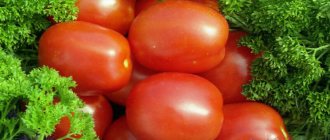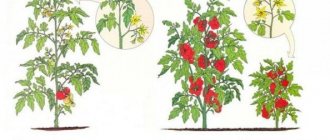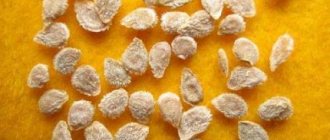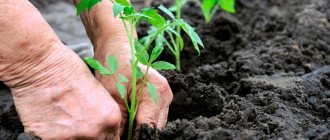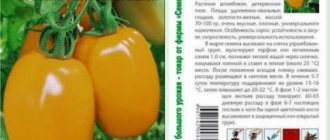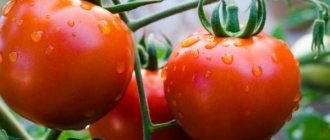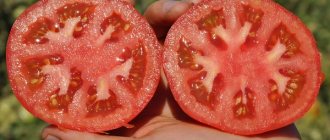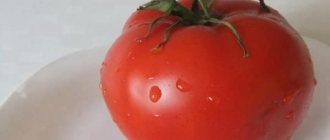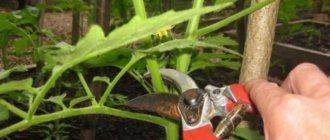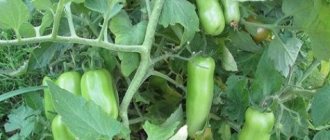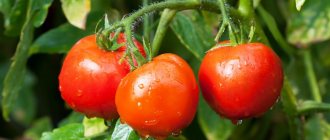Standard varieties of tomatoes are representatives of a group characterized by short stature. Their main difference is their small-sized roots, which do not allow the plant crop to form tall bushes. Such plant crops do not require specific care, which is why they are very popular among novice gardeners. To get a rich harvest, you need to carefully select standard tomato varieties.
The best of them are those that are resistant to various diseases and produce a rich, tasty harvest. So, let’s look at what it is, and what varieties of standard tomatoes?
Standard tomatoes: characteristics and description
Let’s define what the term “standard tomatoes” means.
Standard bush type
In its original meaning, a trunk is a tree trunk, erect and strong. Standard tomatoes are contrasted with liana-shaped ones - with thin and flexible stems. Between these extreme poles there are many intermediate forms (including semi-standard ones). The first breeders of standard varieties thought on an industrial scale. They fought against lodging and irrepressible branching of trunks, breeding varieties with strong and compact stems. Thus, the characteristic “standard” refers to the type of bush (its structure). It is clear that such tomatoes could not be too tall.
Determinism
Most standard varieties are included in the broader group of determinate tomatoes (which can be standard or non-standard). They independently limit growth (verticalize) after the formation of several fruit clusters (usually up to 6 pieces). Among them, a superdeterminant subgroup stands out (with terminating after the release of 2-3 inflorescences).
INTERESTING! Almost all superdeterminate varieties have a standard bush type.
Semi-determinate standard tomatoes
An important direction in modern tomato breeding is the production of innovative standard varieties and semi-determinate hybrids. They are quite tall (up to 120-150 cm), with an extremely strong trunk, close internodes, and short stepsons. Numerous fruit clusters are densely located on the compressed bushes, providing record yields. The plant directs resources not to unbridled growth upwards and to the sides, but to filling the ovaries. Such tomatoes require obligatory garter and generous fertilizing and require moderate shaping. Breeders also do not forget about traditional standard tomatoes - low-growing, unpretentious.
Main settings
Basic characteristics of standard tomato varieties:
- The stems are thick, strong, durable, erect; under the weight of the harvest they can bend, but do not lie flat on the ground. A garter is desirable, but not required.
- Plants are superdeterminate and determinate (sometimes semi-determinate).
- The bushes are compact, with short internodes and short shoots.
- The leaves are most often thickened, rather wide, with strong petioles.
- The root system is not extensive, but lush (fibrous, with an abundance of suction roots).
- The ripening time of tomatoes is from very early to mid-early and medium (there are no late ones).
- In many varieties, flower clusters form early, fruits fill quickly (from flower to ripe tomato it takes 40-45, not 55-60 days).
- The seedlings do not stretch.
INTERESTING! There are no restrictions on the shape of fruits on standard tomatoes, as well as on their color. You can get tomatoes of red, pink, raspberry, yellow, orange, green, black and even variegated colors.
Features of tomato care for the lazy
Caring for this type of tomato does not require much time or special knowledge. The only thing you need to do is regularly water it generously and apply fertilizer 3 times.
Fertilizers are made from organic and mineral fertilizers, which are applied during the growing season:
- Take a 10-liter bucket of mullein or manure solution, after diluting the manure with water 1:9.
- Add 20 g of superphosphate.
- Use a bucket of fertilizer for about 10 plants.
Apply dry mineral fertilizers after 2 weeks.
Don’t forget to also loosen the soil around the tomatoes and hill up the plants.
Only due to their rapid ripening, standard tomatoes very rarely get sick. They are also not affected by late blight, which is especially typical for most common tomato varieties.
3.1. Is it necessary to plant standard tomatoes?
Many gardeners ask this question. If you want the tomato bushes to have the correct stem, then pinching must be done every week. Carry out similar work before lunch in clear weather. In this way, the place of stepson will heal faster and will not be infected with diseases.
If you follow some simple rules, you can grow an excellent and, most importantly, environmentally friendly harvest of low-growing tomatoes on your plot.
- Winter garlic - health benefits and improvement of the site
- Pre-planting treatment of potatoes as a guarantee of a bountiful harvest
- Early Zhukovsky potatoes - growing features
- How to grow cucumbers on the balcony
- Growing potatoes using Dutch technology is the key to a good harvest
Advantages and disadvantages of growing
When selecting an assortment of tomatoes, gardeners and farmers compare their capabilities with the actual characteristics of the standard varieties.
| Advantages | Problems |
| minimum requirements for stepsoning | short fruiting period |
| There are practically no problems with the garter | yield is not maximum for tomato |
| ease of shelter due to low stature | large fruit is a rare characteristic |
| can be planted in open ground | few varieties for long-term storage |
| for any regions | need for rapid processing |
| precocity | overgrown seedlings reduce productivity |
| short ripening time | |
| possibility of mechanized cleaning | |
| early release of beds | |
| suitable as a compactor crop | |
| low costs for pesticide treatments | |
| ecological purity of the harvest | |
| drought resistance | |
| moderate need for fertilizers | |
| stable returns in any season | |
| compactness of seedlings in height and width | |
| non-seedling growing method possible | |
| variety of assortment according to purpose | |
| many non-hybrid varieties (own seeds) | |
| profitable seedlings for market sales |
Expert opinion
Stanislav Pavlovich
Gardener with 17 years of experience and our expert
Ask a Question
IMPORTANT! The main “advantage” of standard tomatoes is the minimum cost with decent returns. These are truly “varieties for the lazy,” but in fact - for busy or inexperienced gardeners, as well as for peasant farms (with an eye to market trade with small financial investments).
Growing conditions
The agricultural technology for cultivating standard tomatoes is not much different from the activities carried out when cultivating conventional varieties. Low-growing plants are grown through seedlings. Seeds are sown in light loose soil, spreading over the surface and slightly pressing. To keep the seedlings healthy, the substrate must be calcined in the oven, and the seeds are kept for about 15 minutes in a manganese solution.
The nuances of planting in open ground
The beds are prepared in well-lit areas with fertile soil. Preparatory work is carried out in the fall, when compost is added to the digging, after removing the roots of predecessors. Seedlings are planted after the threat of return frosts has passed and the soil has warmed up well. In regions with harsh climates, plantings are covered with film.
For your information!
The planting pattern for standard tomatoes is 25 cm between bushes and 60 cm between rows.
Tomato care
Low-growing plants with powerful stems are quite unpretentious:
- Watering - moisten the soil after the top of the earth has dried out, since the root system is superficial and cannot extract water from the meter-thick soil layer, where moisture reserves are stored longer. The water procedure is carried out at the root so that drops do not fall on the shoots and fruits.
- Soil cultivation - the soil is systematically loosened and cleared of weeds, ensuring normal nutrition and respiration for the tomatoes. Garden tools are used carefully so as not to injure the roots located close to the surface. To reduce the time for these procedures, tree trunk circles are mulched with sawdust or peat.
- Fertilizing is carried out only if the soil is very poor. Excess nitrogen can stimulate the growth of green mass to the detriment of ovary and fruit ripening.
- Formation of a bush - standard varieties are rarely planted, since they are not prone to forming side shoots. As a rule, the procedure is carried out only in northern regions to provide light access to fruits that slowly ripen in a cool climate.
- Protection from diseases and pests - as a preventative measure, plantings are treated with a tank mixture of fungicide and insecticide. This is done only in the morning in calm weather according to the instructions for using the drugs.
Standard varieties give a good harvest with minimal care. In conditions of a shortage of time for additional tying and preparation of support, this is the most suitable type of tomato with excellent taste and quality.
Rating of the best varieties
Selection does not stand still. Traditional varieties are being replaced by new ones - earlier and more productive, resistant to diseases and the vagaries of bad weather. Without abandoning the reliable and familiar assortment, one cannot deprive attention of new items.
For greenhouses and greenhouses
Greenhouse and greenhouse standard tomatoes are heat resistant. They set consistently even at high temperatures and changes in humidity. In protected soil, mid-early and mid-ripening varieties can be cultivated - the most productive ones, including large-fruited ones.
Cheerful gnome
A modern Russian variety from breeder L. A. Myazina. The ripening period is medium-early (from 100 days). The bushes grow no higher than half a meter. Foliage is sparse. The tomatoes are sweet, deep red, weighing up to 100 g, elongated-cylindrical (10-12 cm), pickling type. The consistency is fleshy, not watery. One plant produces up to 2 kg of tomatoes.
See also Features of cultivation, characteristics and description of the tomato variety Chio Chio San
Orange cap
Cherry type (weight 16-20 g). Tomatoes are ovoid or spherical, amber-orange, sweet in taste. The bushes are low and extremely compact. The variety is suitable for pot culture and compacted plantings.
Gnome Purple Heart
A tomato of Canadian origin from the “Gnomes” series. Plants are stocky, half a meter in height. The fruits are shaped like a heart or a gnome's cap. The color is non-standard, purple-chocolate or brownish-burgundy, with a greenish tint. The average size of tomatoes is 110-145 g, the record size is 450 g. The pulp is sweetish, salad type.
Gavroche
Super early (80 days), low (45 cm) tomato from Russian agro. This is a cocktail variety, with sweet tomatoes weighing 50 g. They are round, even, bright red. The productivity of each bush is from 1 to 1.5 kg. A thick planting (30 x 30 cm) is recommended. The main purpose of the variety is whole-fruit pickling.
Antoshka
An early ripening variety with egg-yellow, sunny fruits. The size is slightly larger than a cocktail (on average 60-80 g). Tomatoes are round, sometimes slightly flattened at the top. The variety is attractive for its sweetness, which is rare for early tomatoes. The pulp is juicy. The height of the stems does not exceed 0.6 m. Fruiting is long-lasting, including on numerous stepsons. The bushes can be attached to a support or grown without a garter, as a semi-ampelic crop.
The best standard varieties
Among standard tomatoes, not only domestic varieties are popular, but also foreign ones. Each of them has its own characteristics of agricultural technology, and is also endowed with all the advantages listed above.
Tomato varieties for open ground or greenhouses should be selected based on an analysis of the desired results, as well as the climatic conditions of the area
It is also necessary to pay attention to the resistance of the plant crop to various tomato pathologies.
Far North
Of the standard tomatoes for open ground, the Far North variety has proven itself best. This tomato variety has the following characteristics:
- the fruits are round in shape, red in color, with an average weight of 70 grams;
- the height of the bush does not exceed 60 centimeters;
- 7 bushes can be planted on 1 square meter;
- early ripeness: the first harvest can be harvested 100 days after sowing;
- Almost all fruits ripen at the same time.
The description of this variety states that it is resistant to root and blossom end rot, as well as late blight. Of all the standard tomatoes, the Far North variety has a record yield: 2.5 kilograms of tomatoes are harvested from 1 plant. However, such indicators can be achieved provided that all planting care rules are followed. You can study them by watching a video about Far North tomatoes.
Another name for this tomato is Fighter. Plants of this variety are divided into two groups: those that bear red tomatoes and yellow ones. This plant has the following characteristics:
- height characteristics of the bush: no higher than 45 centimeters;
- the first harvest can be obtained 95 days after sowing;
- in the area of the stalk there is a greenish spot, which decreases as the fruit matures;
- the possibility of growing 7-9 plants per 1 square meter in greenhouse structures or in open beds;
- from 1 square meter you can harvest 3-5 kilograms of crop;
- the fruits are characterized by a shape similar to a cylinder;
- this standard variety is resistant to diseases caused by bacteria;
- On average, 1 ripe tomato weighs 75 grams.
These standard tomatoes are suitable for growing in the north-west of Russia, in its southern and central zone.
Shuttle
What low-growing varieties can be grown in open ground? Shuttle is suitable for these purposes. It has the following distinctive characteristics:
- ripe fruits are distinguished by their red color, fleshiness, elastic skin, which protects the vegetable from cracking;
- mid-early ripening period: the harvest can be obtained 85-120 days after sowing;
- the shape of the fruit is oval, and their average weight is 60 grams;
- altitude qualities of the plant: do not exceed 45 centimeters;
- 8-10 bushes can be located on 1 square meter;
- From 1 bush you can harvest 1 kilogram of vegetables.
The plant culture Shuttle is resistant to late blight.
Alpha
The best standard varieties, distinguished by their sweet taste and aroma, are Alpha tomatoes. Moreover, in addition to taste, these plant crops have the following features:
For open ground
Ground tomatoes for northern regions are early or mid-early, often super-determinate. They tolerate cool weather without damage. Southern standard tomatoes must be resistant to the scorching sun and soil drought.
Kobzar (Kobzar Tarasenko)
This is a fairly old amateur variety that is not losing popularity. The reason lies in the excellent resistance to diseases (including late blight) and the beauty of the fruit. The tomatoes are crimson-red, spherical or oval, with a spectacular convex “nose”. Size 70-95 g. The fragrant fruits are tasty both in pickling and in fresh salads. The bush grows up to 55-65 cm. The ripening period is average (115-120 days). Garter is required.
Severin
Despite the name, the variety is characterized as heat-resistant and tolerant of soil drought. He is very demanding when it comes to nutrition. Tomatoes ripen quickly, in mid-early or medium terms (110-115 days). The bush rises half a meter above the ground. The barrel is extremely durable. Tomatoes resemble a smooth, oval plum with a dark red hue. Fruit weight is from 60 to 80 g. The consistency is dense, low-juicy; canning purpose. Tomatoes are suitable for long-term fresh storage.
Shuttle
This unpretentious variety was bred in the Moscow region. Recommended by the State Register (since 1997) for cultivation in the Middle Zone, Volga-Vyatka region, Western Siberia. The first fruits ripen very early (from 82 days). They are oval-elongated, with a graceful “nose”, glossy red, 25-60 g in size (cocktail type). Purpose: salad and canning. The stem is erect, strong, no higher than 45 cm; branching is weak. Susceptibility to late blight is average. Industrial yield is determined in the range of 20-80 kg per 10 square meters. m.
Rose of Wind
The popular early (95 days) tomato from St. Petersburg Agro attracts with its cold resistance and unpretentiousness. The stem is erect, no higher than 45 cm. Can be cultivated without forming and removing stepsons. The tomatoes are beautiful, raspberry-pink, spherical. Meatiness, excellent taste, transportability and good size (125 g) are a rare combination of characteristics for such an early ripening variety.
Ranetochka
This is a cocktail-type tomato (30-40 g) with a friendly early (90 days) ripening. The ovary is stable. The tomatoes are bright scarlet, round, and moderately transportable. The plants are so compact that it is permissible to plant 8-9 bushes per 1 square meter. m. Stem height 0.5 m. Average productivity – 5.2 kg/sq. m.
Watercolor (Improved cream)
This new product from Siberia is resistant to blossom end rot and septoria. Ripening is medium early (100 days). Fruitfulness up to 80 kg per 10 sq. m. Low plants (0.4 m) do not need shaping. The size of the tomatoes is 55-90 g (up to 120 g), the color is light red. The pulp and skin are dense. Tomatoes are successfully ripened, do not spoil for a long time, and do not wrinkle during transportation or during pickling.
Universal purpose
Standard tomatoes, resistant to sudden changes in temperature and humidity, successfully bear fruit both indoors and outdoors.
Lion Heart
There are several varieties of tomatoes with this name. Since 2006, a determinate variety with a medium ripening period (110-120 days) has been registered in the State Register. In open ground, cultivation without shaping is allowed; In the greenhouse it is advisable to do moderate pinching. Massive clusters bear 6-8 ovaries, each of which fills up to 110-190 g. The tomatoes are round, raspberry-red, fleshy, salad type. In protected soil, productivity reaches one and a half centners per 10 square meters. m, in street beds they get 35 kg from a similar area.
Bushman
Ripe tomatoes begin to be picked from a low bush (45-50 cm) 3 months after the start of the growing season. The fruits are spherical-flattened, bright scarlet, with loose flesh. Weight 85-105 g. The variety adapts to various soils and growing conditions, and successfully resists diseases. It ties without problems even in cool and rainy weather, in damp areas.
Buyan (Fighter)
The popular and extremely unpretentious tomato has been on the Russian State Register since 2000. The variety has a patent as a valuable breeding achievement. Recommended for cultivation in all regions. According to gardeners, the Fighter (Buyan) tomato stands out for its stable productivity from year to year. There are gardeners who grow only this variety and are quite satisfied.
The bushes are low (up to 45 cm), with moderate branching. They don’t have to be shaped or can be stepped only up to the first brush. Internodes are short. The flower stalks emerge from the axils of leaves 6-7. Tomatoes begin to turn red on the 90th day. Size 65-90 g (maximum up to 120-180 g). The shape is a smooth cylinder, sometimes with a slight “spout”. The variety is resistant to drought, cold snaps, and viral diseases.
Cameo
This tomato was bred in the Moscow region, but is recommended by the State Register (since 2001) for Western Siberia. Ripening is fast, very early (from 89 days). Plants practically do not suffer from cladosporiosis and septoria, are not affected by the mosaic virus, successfully resist late blight, and are not afraid of cold snaps. The ovary is stable in any conditions. Low bushes (0.5 m) can be grown without supports and not shaped. Tomatoes are spherical or round-flat, bright red. Size 60-100 g. Industrial productivity is estimated at 35-45 kg per 10 sq. m; in private gardens this figure is higher.
See also: The best tomato varieties for Siberia in a greenhouse
Sultan F1
The hybrid belongs to the “beef-tomato” (“beefsteak”) type. Salad fruits are fleshy, tender, highly rated when tasting. The shape is rounded-flat, with slight ribbing. Color blood red; size 140-210 g. Medium early ripening (93-112 days). The height of the stem rarely exceeds 0.6 m - even in closed ground. The hybrid does not suffer from fusarium and verticillium and easily adapts to any growing conditions.
Tomato varieties resistant to late blight
We will separately highlight tomato varieties that are less affected by the dangerous late blight. This is explained by the fact that many mid-season and late indets are grown in polycarbonate greenhouses, and it is at the end of summer that late blight begins to rage in the areas.
Choosing late blight-resistant tomato varieties for the greenhouse will allow you not to lose your harvest, but you still shouldn’t forget about preventive measures.
It is also very important to follow planting patterns. Among the Indians, seedlings are planted maintaining distances (2-3 bushes per 1 sq.
meter) so as not to crowd the space.
Barberry F1
Based on its resistance to late blight, we will highlight this productive cluster hybrid, which forms clusters with numerous fruits. Each tomato weighs about 40 grams. Tomatoes are raspberry-colored, very dense, intended mainly for marinades and preservation.
Money bag
Also from the group of carpals, we note the Money Bag variety, which, thanks to its early ripening, manages to “escape” from diseases.
A very productive tomato with bright red fruits. Up to 12-15 tomatoes are formed in one brush, dense, tasty, weighing up to 80 grams.
Monomakh's hat
The bush of this variety grows up to about one and a half meters, characterized by good yield and resistance to late blight.
The first fruits weighing about 500-600 grams from the plant can be harvested after 110 days. Pink tomatoes are not only large, but also very beautiful. Their shape is round and has slight ribbing. The pulp is sugary and juicy; droplets of juice are even visible on the crack.
It is a salad variety; the fruits are also used to produce paste and delicious juice.
Tomatoes such as Supersteak F1, the productive hybrid Intuition (very shade-tolerant), and the exotic Black Truffle, which is not only very tasty, but also shelf-stable, also resist late blight well. In the group of late blight-resistant tomatoes there are also indeterminate tomatoes that do not require pinching, for example, the Bolero hybrid.
Features of planting
The most important factors that directly affect the yield of standard tomatoes are the timing and density of sowing and planting.
Basic recommendations:
- Ultra-early varieties can be sown directly into a greenhouse, an unheated greenhouse, or a temporarily covered outdoor garden bed.
- The permissible plant density during the seedling period is 4 X 4 cm (twice as dense as for non-standard tomatoes).
- For early ripening and mid-early standard varieties, the optimal age of seedlings when planting (in a permanent place) is 35 - 45 days. Overgrown seedlings are worse than undergrown ones.
- Moderately thickened planting (5 - 9 pcs./sq. m) is the key to high productivity (good output per unit area).
- Strict crop rotation will eliminate the need for pesticide treatments.
- There is no need to add large amounts of fertilizer.
Standard tomatoes develop successfully in moderately fertile soils. Before planting, the beds are filled with organic matter (humus, compost - up to a bucket per 1 sq. m) and wood ash (1-2 cups per 1 sq. m).
INTERESTING! Super-determinate standard varieties can be planted along paths and in flowerpots (for decoration), and can also be used as a compactor crop (for example, in cabbage plantings, along the edge of cucumber beds, next to tall tomatoes, etc.)
Tomatoes for an open garden
There are a lot of varieties of standard tomatoes. They all have their merits.
Snegirek
The fruits of this species are small, elastic and juicy. They weigh only about 150 g. Tomatoes taste very sweet. They ripen quickly.
Attention! The Snegirek variety can be grown not only in open ground, but also on a windowsill.
This will not reduce the yield. The bush is small in height (does not exceed 50 cm). The root system of the plant is also small.
Altaechka
"Altaechka" is noted for its very rich yield. The fruits are beautiful and plump. They reach 150-300 g in weight. They are a bit like an oval in shape. The bush itself grows 70-90 cm in height. It is worth noting that the plant copes well with diseases such as late blight rot.
Severin
Severin tomatoes have an average ripening time. The stem grows up to 50 cm. Minimal care for this plant is not a hindrance. The harvest will still be high. Use Severin for canning, sauces, and salads.
This tomato has a thick, elastic shell. This increases resistance to cracks. Even cut, it holds its shape perfectly. The fruits are stored for a very long time.
pepper baby
Standard tomatoes “Pepper Baby” are red, dense and oblong. In this way they resemble bell peppers. They are very fragrant and taste sweet. The average weight of the fruit reaches 160 g. The bush itself is compact, no higher than 30 cm.
Flame Agro
“Flame Agro” received its name due to the rich fiery red color of the fruit. The tomato grows up to half a meter in height. Its leaves are highly corrugated and have a dark green tint. The vegetables themselves weigh about 125 g. Most often, the fruits of this representative are used to prepare tomato juice.
Gold
Tomatoes of this variety have an unusual shade - yellow-orange. That's why it was called "Golden". Ripens early. The yield is high. If you perform pinching, fruiting will increase.
Advice! “Golden” does not contain allergens.
That is why it can and should be eaten by people who are allergic to regular tomatoes.
Shchelkovsky early
A very compact standard variety - up to 70 cm in height. The fruits are medium - about 100 g, but very aromatic and tasty. Shchelkovsky early tomatoes ripen at the same time.
There is no need to wait for individual fruits to ripen. That is why this type of tomato is most often grown for sale.
Kobzar
"Kobzar" grows up to 70 cm in height and is not characterized by high yield. But tomatoes taste very pleasant. Ripe vegetables are colored bright crimson. They do not ripen at the same time. Weight reaches 100 g.
Summer resident
This is an early ripening standard variety. The tomato grows up to 60 cm in height and has large fruits. Tomatoes weigh 200 g. Their texture is meaty and juicy. The “dacha resident” is not picky.
Productivity will be high, regardless of weather conditions. Even in cloudy regions, the plant produces a large number of fruits.
We examined in detail standard tomato varieties for growing in open ground. As a rule, such species do not require special knowledge and skills of a gardener. They also do not need careful care. However, there are also universal varieties of standard tomatoes. Let's take a closer look at them.
How to care for standard tomatoes
Reviews from many gardeners that you don’t need to care for standard varieties at all is a statement close to the truth. This is the only group of tomatoes that is almost guaranteed to produce a harvest under any circumstances (if high-quality seedlings are planted correctly). But competent agricultural technology will increase the productivity of plantings.
Useful activities:
- Periodic watering (overflow, without sprinkling) with slight drying of the top layer of soil.
- Mulching.
- Two complex root feedings – (when the first buds emerge, at the initial stage of fruit filling)
- Watering and spraying with biological fungicides (Fitosporin, Sporobacterin) to prevent diseases.
- Garter to any type of support.
Expert opinion
Stanislav Pavlovich
Gardener with 17 years of experience and our expert
Ask a Question
IMPORTANT! Stimulants will help support immunity and ensure a stable ovary. In hot and dry weather, it is useful to spray the bushes with Zircon, and in case of sudden cold weather - with Epin Extra. Microfertilizer (Tsitovit, Sudarushka, Zdraven, Agricola, Kristalon) is added to the solution.
Features of growing low-growing varieties in greenhouses
Low-growing varieties are much easier to grow in greenhouses than tall varieties. They do not need to remove the shoots and tie them to trellises, except in cases where the plant falls to the ground under its own weight.
The agricultural technology of determinate tomatoes is generally the same as that of other varieties. But there are some peculiarities here.
- Seeds. It is better not to save on their purchase, but to buy really high-quality seed.
- Seedling. In order for the plant to quickly gain green mass and begin to bear fruit, the seedlings must be healthy and strong. It is planted in the ground when the first buds begin to form - at the age of 40-45 days.
When planting, adhere to the following scheme:
- The soil in the greenhouse is prepared two to three days before planting. It is loosened, organic fertilizer is applied and holes are prepared at a distance of 35 cm.
- Before planting, the holes are deepened to 20 cm. 200 ml of a pink solution of potassium permanganate is poured into them to disinfect the soil.
- The seedlings are taken out of the pots, planted in holes and the soil is thoroughly pressed down. Water generously with warm water
- The seedlings are watered for the first time after five to seven days. She is fed with mullein solution. In the future, the plants are regularly watered and fertilized.
- If the plants are not standard, then during development they need to pinch off the shoot responsible for vertical growth. When the plant begins to branch, two or three branches are left, the rest are removed.
- For non-standard, low-growing bushes, it is necessary to pinch or break out all the stepsons.
The main condition for growing low-growing varieties is the correct choice of seeds and compliance with agricultural technology conditions. In this case, you will get a good harvest with much less effort than when growing tall plants.
Specifics of bush formation
For standard tomatoes, three shaping options are possible.
Without stepsoning
It is permissible not to touch the bushes at all, approaching them only for harvesting. This is most relevant for super-determinate varieties. In this case, one should not hope for an ultra-early harvest and large fruits. But it saves energy and time for other things.
Until the first brush
This is the optimal shaping option for standard tomatoes, especially early and mid-early ones. The work is performed once per season. When the first brush blooms (a little later), under it (to the ground) all the side branches (stepchildren) are plucked out from the plant (leaving a small stump). Side shoots coming out of the ground at the base of the bush are also removed. The stepsons that appear higher will grow into a compact “cap” and set fruit.
Results of pinching to the first brush:
- earlier ripening of tomatoes;
- increase in fruit size;
- achieving maximum yield for the variety (realization of potential).
Full stepsoning
Sometimes it is useful to remove ALL stepsons (not forgetting about the root shoots).
Possible situations:
- northern region with short summers;
- seedless method of cultivation, late sowing;
- the desire to get record-breakingly large fruits;
- excessively thick planting;
- shaded garden bed;
- wet season;
- outbreak of a fungal or bacterial disease on tomatoes.
INTERESTING! Standard tomatoes do not need to be topped (pinching out the growing points) at the end of the season. They independently regulate their development and complete it in a timely manner.
Standard varieties of tomatoes for greenhouses
Bekhtemir is a mid-late plant with very sweet tomatoes that rarely crack. The fleshy fruits weigh about 70 grams. The bush is abundantly covered with tomatoes, which often causes it to fall to the ground. The plant does not suffer from this, and there is no need to tie it up. According to reviews from summer residents, it is possible to remove a bucket of fruit from each bush during the season.
Boni-M is an early ripening, standard variety. According to reviews from summer residents, the first fruits can be harvested within 80-85 days after planting the seedlings. The fruits grow neat, round, fragrant, weighing up to 100 grams. 10-12 tomatoes ripen on the bush at the same time.
Belgorod cream is a mid-early tomato that has proven itself well and has a lot of positive reviews from summer residents. The fruits weigh up to 85 grams, are fleshy, sweet, with thin skin, very aromatic. The plant is resistant to fungal infections and the bushes can be arranged quite closely in the greenhouse.
Bushman is a tomato that is recommended for growing in southern regions with arid climates. Bushman is ideally adapted to the weather of the Krasnodar Territory and Crimea. Even with a lack of moisture, the powerful roots of this standard variety receive enough nutrients to form tasty, sweet tomatoes. Bushman fruits weigh up to 120 grams, and the height of the bush is about 50 cm and does not need a garter.
Gavroche is an early variety for greenhouses. The bush is compact, rarely grows above 50 cm. Productivity is average. From one plant it is possible to obtain up to 2 kg of sweet, fleshy, round tomatoes, weighing no more than 50 grams each. Tomatoes in the greenhouse are distinguished by good disease resistance.
Thanks to their powerful roots, standard tomato varieties receive enough nutrients, which has a positive effect on the taste of the fruit.
Denis is one of the shortest standard varieties. The average height of the bush is 35-40 cm. The fruits of the variety are large, pink, have a perfect round shape, and weigh up to 280 grams. Its advantage is that the tomatoes are not prone to cracking and, according to reviews, are very sugary.
Lionheart is a large-fruited tomato, weighing more than 300 grams. The plant is perfectly adapted to growing in regions with high humidity, tolerates drops in air temperature well, and is resistant to late blight. Pink fruits do not crack from excess moisture, but have a low sugar content.
Standard varieties of tomatoes for open ground in Siberia
Subarctic is a very early variety obtained by Dutch scientists. The bush grows compact with many small tomatoes. The fruits are perfectly smooth, even, rich red in color, and sweet. Tomatoes have a long shelf life and tolerate transportation well.
Dwarf is an early ripening variety of tomato, characterized by a compact bush and small, sweet fruits. The height of the plant is about 50-60 cm. The fruits are medium-sized, weighing 50-70 grams. According to reviews, they grow well balanced in terms of sweetness and meatiness.
Pinocchio is a dwarf bush that can be grown not only in greenhouses, but also at home all year round. The plant has a height of up to 30-35 cm, and the mass of small fruits is 25 grams. Housewives love it precisely for its small fruits, which look very attractive on the table in fresh or canned form. From each bush you can collect 1.5-2 kg of sweet-tasting tomatoes.
Beta is an early variety that produces a lot of sweet and juicy tomatoes. The height of the bush is up to 50 cm, weighs up to 65 grams, and has a deep red color. The fruits are moderately juicy, they have small seed chambers, and a pleasant aroma. Stores well and is ideal for canning.
Maestro - has oblong fruits, medium late, very productive. Tomatoes are great for canning, making adjika, borscht seasoning, and ketchup. The average weight of one tomato is 65-75 g. According to reviews, fleshy vegetables tolerate long-term transportation well and have a long shelf life.
Funtik is a low-growing plant, the fruits of which can be collected 100 days after planting. They are small, round, weighing no more than 40 grams. The variety is ideal for growing in a greenhouse, on a glazed balcony or loggia.
Standard tomato varieties of Ural selection, the most productive, video
Are you choosing productive standard varieties of tomatoes for open ground or a greenhouse? Breeders have received more than 100 low-growing varieties, which are recommended for cultivation in open and protected ground conditions. By forming a standard variety bush with 1 stem, summer residents get up to 8 kg of sweet tomatoes per bush! Choose a tomato variety, share your experience, write comments. Your feedback will help novice gardeners become successful.
Possible difficulties
Standard tomatoes are considered the most problem-free. Difficulties may be associated with ignorance or non-compliance with agricultural technology and varietal characteristics.
Common problems and errors:
- Low quality of seeds, mis-grading.
- Sowing seedlings too early.
- Growing seedlings in heavy soil mixtures, in nurseries without drainage holes.
- Late pick.
- Sparse or dense planting in the garden bed.
- Excessive watering, excessive fertilizing.
- No garter for medium-sized varieties with full-bodied tassels.
- Unpreparedness for rapid processing (sale) of fruits with a friendly return of the harvest.
Reviews from farmers about standard tomatoes
Farmers and owners of small peasant farms value standard tomatoes for their unpretentiousness and stable payback at low financial costs. If you use your own high-quality seeds and available natural fertilizers, then to get real profit you only need land and your own labor. There is no need to build complex greenhouses, purchase chemicals for their regular processing, or spend money on expensive hybrids. According to farmers, growing standard tomatoes is a feasible start for a beginner in the agricultural business. Tomatoes are a product that is always in demand on the market, since it is one of the favorite and necessary vegetables.
Previous
TomatoesPicking dates for tomatoes in March 2021
Next
TomatoesNuances of growing, characteristics and description of tomato Azhur
